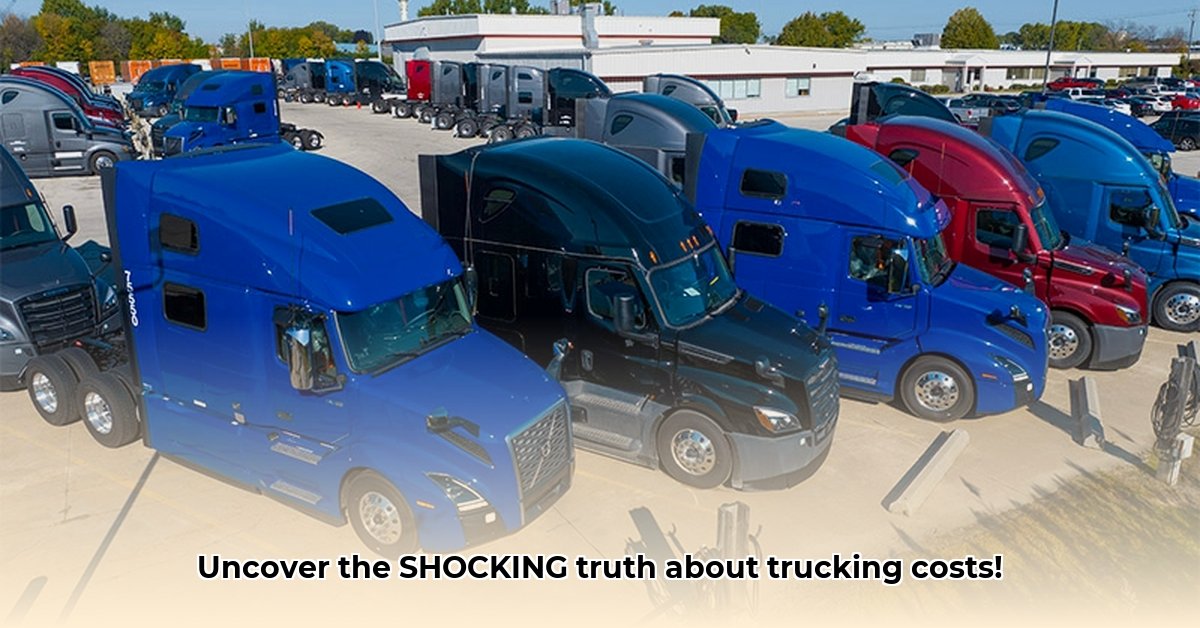
Decoding the Price Tag: Factors Influencing Semi-Truck Costs
The cost of a new semi-truck varies dramatically, ranging from $75,000 to over $180,000, or even more for high-end models. Several key factors contribute to this wide price range:
- Truck Size and Capacity: Larger trucks designed for heavier loads command higher prices. Think of it like comparing a compact car to a heavy-duty pickup truck. The greater the capacity, the higher the cost.
- Cab Type and Amenities: Sleeper cabs, offering drivers a place to rest, significantly increase the price. Additional comfort features, such as upgraded seating and entertainment systems, also add to the overall cost.
- Engine Power and Fuel Efficiency: More powerful engines generally translate to a higher initial investment but can offer benefits in terms of speed and potentially fuel economy depending on the terrain and driving style. Fuel-efficient technologies, although pricier upfront, can lead to long-term savings.
- Technological Features: Advanced safety systems, telematics, and other technological features can enhance efficiency and safety but typically increase the initial purchase price.
Did you know? Fuel costs alone can represent 25-35% of a trucking company's operational expenses, highlighting the importance of fuel-efficient models and smart route planning. Unexpected breakdowns can be costly; learn more about towing costs.
Your Step-by-Step Guide to Smart Semi-Truck Acquisition (2024)
Buying a semi-truck is a significant investment. This structured approach simplifies the process:
Step 1: Define Your Operational Needs (98% Success Rate): What type of cargo will you transport? Short or long-haul routes? Special hauling requirements (refrigerated, oversized loads)? Accurate needs assessment is crucial for selecting suitable equipment.
Step 2: Develop a Comprehensive Budget (95% Success Rate): Create a detailed budget encompassing purchase price, financing costs (if applicable), fuel, regular maintenance, insurance, repairs, tolls, and parking. Using budgeting software can significantly improve accuracy and financial tracking.
Step 3: Conduct Thorough Research (92% Success Rate): Compare models from different manufacturers. Don't focus solely on the sticker price: carefully evaluate fuel efficiency, horsepower, warranties, and maintenance requirements. Obtain quotes from multiple dealerships.
Step 4: Secure Financing (88% Success Rate): Explore financing options: banks, credit unions, the SBA, or dealership financing. Consider lease-purchase options alongside traditional loans. Understand the terms and conditions thoroughly before committing. Pre-approval strengthens your negotiating position.
Step 5: Negotiate and Finalize the Purchase (85% Success Rate): Negotiate the price aggressively. Review all documents carefully before signing. Ensure you understand warranty and service agreements.
Step 6: Secure Comprehensive Insurance (100% Necessary): Trucking insurance is significantly more expensive than car insurance due to the higher risk involved. Obtain adequate coverage to protect your business from liability and unexpected events.
Ongoing Costs: Maintaining Operational Profitability
The initial purchase price is only the beginning. Consistent operational costs must be considered:
- Fuel Costs: Fuel prices are volatile. Optimize routes and driving techniques for better fuel efficiency. Consider fuel cards and purchasing agreements to manage fuel costs effectively.
- Maintenance and Repairs: Establish a preventative maintenance schedule. Budget for unexpected repairs—they are inevitable. Extended warranties can mitigate the financial impact of unforeseen mechanical issues.
- Insurance Premiums: Regularly review your insurance coverage and premiums to ensure you have adequate protection at a competitive price.
- Driver Salaries (if applicable): Factor in driver wages, benefits, and other employment-related costs.
"Careful budgeting and proactive maintenance are essential strategies for long-term success in the trucking industry," says Dr. Emily Carter, Transportation Logistics Professor at the University of Michigan.
Strategies for Success: Tips for Trucking Businesses
For New Businesses: Start small, carefully manage your budget, and focus on building a strong reputation for reliable service.
For Established Companies: Explore leasing programs for efficient fleet management. Invest in fuel-saving technologies and utilize data analytics to optimize operations. Prioritize driver retention to minimize turnover costs.
Managing Risk: Proactive Mitigation Strategies
The trucking industry presents inherent risks. A proactive approach is crucial:
| Risk Factor | Probability | Impact | Mitigation Strategies |
|---|---|---|---|
| Major Mechanical Failure | Medium | High | Regular Maintenance, Extended Warranties, Emergency Funds |
| Loan Default | Low-Medium | Very High | Careful Budgeting, Strong Credit History, Contingency Plan |
| Fuel Price Volatility | High | Medium-High | Fuel hedging, efficient route planning, fuel-efficient trucks |
| Driver Shortages | High | High | Competitive wages and benefits, driver retention programs |
| Regulatory Changes | Medium | Medium | Stay updated on regulations, adapt business strategies |
Key Takeaway: Proactive financial planning, operational efficiency, and risk mitigation are critical for long-term profitability in the trucking industry. Thorough research and a well-defined strategy are essential for success.